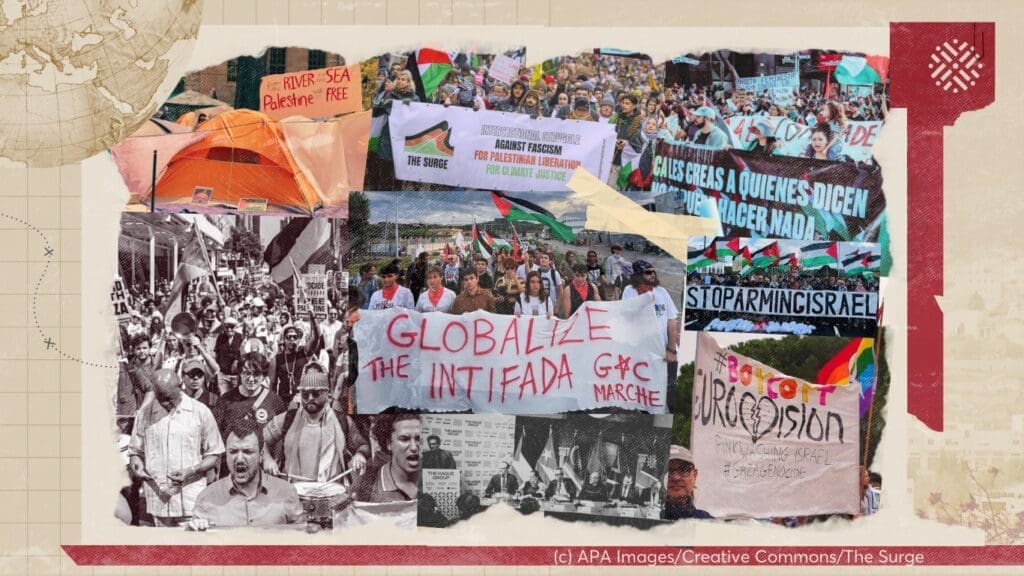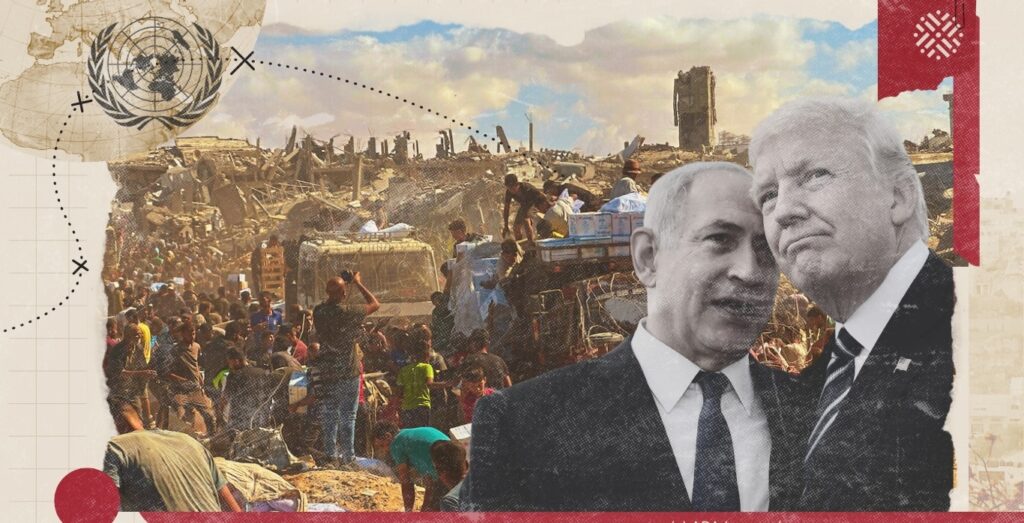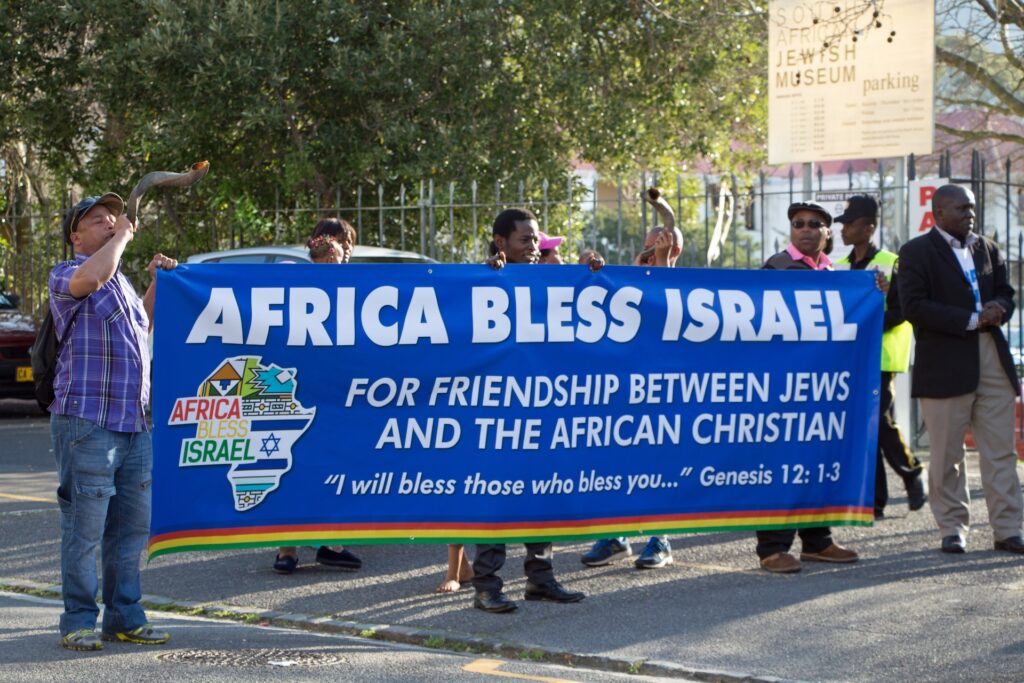- Topics
-
Topics
See our analysis on civil society and how it shapes culture, politics, and policies
Read our insights on the shifting political landscape and what it means for Palestine
Learn more about the policies and practices shaping the Palestinian economy
Strengthen your understanding of the unique conditions for Palestinian refugees across the Middle East
-
- Analysis
-
Analysis
In-depth analysis on existing or potential policies that impact possibilities for Palestinian liberation.
Insights and perspectives on social, political, and economic questions related to Palestine and Palestinians globally.
Concise analysis into a specific policy, its background and implications.
Commentary that brings together insights from multiple analysts.
Compilations of past Al-Shabaka works surrounding a specific theme.
Longer-form, ad hoc projects that seek to confront research questions outside the scope of our regular analysis.
A policy-driven research initiative by Al-Shabaka: The Palestinian Policy Network.
Our monthly webinar series that brings together Palestinian experts.
Featured
The global reckoning that followed October 7, 2023, marked a profound rupture in how Palestine is understood worldwide. The Gaza genocide exposed how Israeli mass violence is not exceptional or reactive, but foundational to the Zionist project. What was once framed as a “conflict” to be managed is now widely recognized as a system of domination to be dismantled. It ushered in a shift away from the technocratic language of peace processes and toward an honest confrontation with the structural realities Palestinians have long named: settler colonialism, apartheid, and the ongoing Nakba. The commentary argues that the Israeli genocidal campaign in Gaza has radicalized the world. When crowds march through global capitals demanding a free Palestine, they simultaneously articulate demands for the abolition of racial capitalism, extractive regimes, climate injustice, and all forms of contemporary fascism. In this moment of radical clarity, Palestine becomes a lens through which the underlying architecture of global domination is laid bare—and through which new horizons of collective freedom emerge. Tareq Baconi· Dec 21, 2025Inès Abdel Razek and Munir Nuseibah joined Al-Shabaka for a conversation on the politics behind the UNSC resolution, the implementability of the US-Israeli plan, and the scenarios now being advanced for Gaza and for Palestine more broadly.
Tareq Baconi· Dec 21, 2025Inès Abdel Razek and Munir Nuseibah joined Al-Shabaka for a conversation on the politics behind the UNSC resolution, the implementability of the US-Israeli plan, and the scenarios now being advanced for Gaza and for Palestine more broadly.
 European empires used Christian missions to legitimize conquest in Africa and advance imperial interests, laying the groundwork for a political form of Christian Zionism. British evangelicals were central in transforming Christian Zionism from a theological belief into an imperial strategy by promoting Jewish resettlement in Palestine as a means of extending British influence. This fusion of religious ideology and imperial ambition endures in contemporary Christian Zionist movements, which frame modern Israel as the fulfillment of biblical prophecy and recast Palestinian presence as an impediment to a divinely ordained order. This policy brief shows how these narratives and their policy effects have taken root in the Global South, including in South Africa. In this context, Israeli efforts increasingly rely on Christian Zionist networks to weaken longstanding solidarity with Palestinians and cultivate support for Israeli occupation.
European empires used Christian missions to legitimize conquest in Africa and advance imperial interests, laying the groundwork for a political form of Christian Zionism. British evangelicals were central in transforming Christian Zionism from a theological belief into an imperial strategy by promoting Jewish resettlement in Palestine as a means of extending British influence. This fusion of religious ideology and imperial ambition endures in contemporary Christian Zionist movements, which frame modern Israel as the fulfillment of biblical prophecy and recast Palestinian presence as an impediment to a divinely ordained order. This policy brief shows how these narratives and their policy effects have taken root in the Global South, including in South Africa. In this context, Israeli efforts increasingly rely on Christian Zionist networks to weaken longstanding solidarity with Palestinians and cultivate support for Israeli occupation. Fathi Nimer· Dec 7, 2025
Fathi Nimer· Dec 7, 2025
-
- Resources
- Media & Outreach
- The Network




Normalizing Israeli Impunity and Dominance: The Arab Role
Introduction
The October 7, 2023, Al-Aqsa Flood operation aimed to revive Palestinian armed resistance and reassert the cause in Arab and global consciousness after years of marginalization. It dealt a major blow to Israel’s deterrence, rupturing its image as a secure colonial outpost entrusted with protecting Western strategic interests. It also exposed cracks in its militarized social contract that rests on the regime’s ability to protect its settler population. While the operation imposed new political realities on the Israeli regime, it has come at a staggering cost to Palestinian life: Israel’s genocidal assault on Gaza has unleashed one of the worst humanitarian crises in recent memory.
Yet the anticipated wave of Arab solidarity following the operation failed to materialize or translate into concrete policy shifts. Instead, the moment laid bare the entrenched ties between Arab regimes and Israel’s settler-colonial project that are rooted in mutual interests, regime preservation, and a shared antagonism toward Palestinian resistance. This commentary argues that these alliances—sustained by repression and strategic-economic cooperation and reinforced by Western complicity—transformed a potential turning point for isolating the Israeli regime into an opening for intensified colonial expansion and regional dominance.
Arab Collusion, Constraint, and Capitulation
One of the most striking aspects of Arab regimes’ policies that have emboldened Israel is the accelerating normalization of ties. The expansion of normalization reflects the post–Arab uprisings landscape, in which counterrevolutionary forces have entrenched autocratic rule and US-aligned regimes have prioritized survival and self-interest over regional solidarity and Palestinian rights. Amid economic collapse, repression, and civil wars, Palestine—though still emotionally resonant—has been increasingly sidelined by fractured societies and shifting strategic alliances.
The normalization framework has not only cemented Israel’s regional dominance but also shielded its escalating violence in Gaza, Iran, and Syria from meaningful accountability. Share on XThis broader regional realignment paved the way for the Abraham Accords, launched in 2020, which have remained remarkably resilient despite ongoing mass atrocities. The UAE and other signatories have prioritized strategic cooperation with the Israeli regime, even as the genocide continues to ravage Palestinian life. Israeli Prime Minister Benjamin Netanyahu’s government has seized upon this permissive environment to intensify its military campaigns and accelerate territorial consolidation, in line with his stated aim to “dramatically change the face of the Middle East.” The normalization framework has not only cemented Israel’s regional dominance but also shielded its escalating violence in Gaza, Iran, and Syria from meaningful accountability.
The Abraham Accords and Israeli Impunity
The Abraham Accords have integrated Israel and several Arab regimes into a US-led security and economic architecture, entrenching Israel’s settler-colonial project at the heart of regional politics. Marketed as “peace agreements,” they are, in fact, transactional pacts prioritizing profit and militarized geopolitics over justice and liberation, granting Israel near-total impunity. Strikingly, during its genocidal campaign in Gaza, trade between the Accords signatories and Tel Aviv rose by 24 percent—reaching $10 billion—even as Israel’s global trade declined by 14 percent. Unsurprisingly, Israel has emerged as the primary beneficiary.
The Accords have precipitated three structural shifts with far-reaching implications for regional dynamics and prospects for Palestinian liberation:
The Accords fractured the fragile Arab consensus that had once tied normalization to the recognition of Palestinian statehood, enabling Israel to secure diplomatic and economic ties while continuing its occupation and settlement expansion unimpeded by unified Arab resistance.
The agreements entrenched a fatalistic acceptance of Israeli dominance, replacing collective Arab agency with an accommodationist logic. Opposition to normalization, once rooted in solidarity and Palestinian self-determination, is now dismissed as impractical or obstructive to autocratic regimes’ self-serving pursuit of “peace and prosperity.”
The Accords recast Israel from a source of instability to a central security partner, aligning it with Arab states and the US in a regional alliance aimed at countering Iran and resistance movements, diverting attention from Palestine and ongoing Zionist colonization.
Meanwhile, Arab civil society—once central to regional solidarity—has been weakened by repression. Additionally, the disillusionment with the outcomes of past uprisings has dampened the appetite for collective mobilization. While October 7 spurred renewed public engagement—from boycotts to aid efforts and protests against normalization—this momentum has yet to translate into sufficient pressure to effect meaningful policy shifts at the governmental level.
In this context, October 7 exposed a deep rift between the resurgence of Palestinian resistance and a politically stagnant region subdued by normalization, securitization, and counterrevolutionary policies. The alignment of Arab regimes with Israeli objectives has enabled Israel to wage a genocidal campaign in Gaza with impunity while also creating a strategic opening to expand its regional influence and aggression elsewhere.
The Axis of Resistance and the War on Iran
The Axis of Resistance—a regional alliance led by Iran and comprising Hezbollah in Lebanon, various Iraqi armed groups, Hamas and Islamic Jihad in Palestine, and Ansarullah in Yemen—has long positioned itself as a counterforce to Israel’s genocidal campaign in Gaza and its broader regional aggression. It has provided financial and military support to Palestinian factions and backed Gaza’s armed resistance for decades, particularly following October 7. Through asymmetric warfare and coordinated operations across multiple fronts, the Axis challenged Israel’s conventional military superiority, exposed weaknesses in its regional posture, and exacted considerable human and economic costs.
Israel’s incursion into Syria, met with minimal resistance, marks one of the most seamless and uncontested phases of its settler-colonial expansion since the 1948 Nakba Share on XBefore its latest aggression against Iran, the Israeli regime had pursued a strategy of isolating and targeting each component of the Axis individually. It devastated Hamas in Gaza by slaughtering the population and weakened Hezbollah through the assassination of key leaders—including Sayyed Hasan Nasrallah—and targeted the group’s social base. In Yemen, it struck ports and critical infrastructure with US support.
Concurrently, Israel intensified covert operations targeting Iranian personnel and assets while advocating for US military action against Iran’s nuclear infrastructure. This escalatory trajectory culminated in direct Israeli aggression on Iranian territory, which cannot be divorced from the broader geopolitical architecture of impunity that enables Israeli violence. The war on Iran constitutes a qualitative shift to state-to-state confrontation, the first of its kind since the 1973 war, aimed at altering the regional power dynamics in favor of the Israeli objective to secure unchallenged regional dominance. It also serves a discursive and political function to redirect attention from Israel’s ongoing genocidal campaign in Gaza. The largely muted, and in some cases tacitly or overtly approving, responses from Arab regimes expose the entrenched strategic convergence with Israeli and US regional imperatives.
The New Syria and Israel’s Colonial Advance
Before Israel’s twelve-day war on Iran, the Axis of Resistance was already weakened by internal strains, most notably the Assad regime’s moral and political bankruptcy. Syria under Bashar al-Assad lacked ideological commitment to the Axis as it prioritized regime survival. This opportunistic approach became starkly apparent in Assad’s pre-collapse rapprochement with the UAE and Saudi Arabia—a strategic pivot widely interpreted as an attempt to distance himself from the Axis. In addition, while Syria’s geographic position made it indispensable to the Axis by linking Iran to Lebanon and serving as a conduit for arms, Assad’s brutal suppression of his population complicated that role.
Mainstream media outlets amplified the sectarian framing of the post-2011 Syrian civil war, portraying Syria as an “Alawite-led regime” violently repressing a “Sunni majority.” This narrative gained traction across the Arab world, where existing sectarian tensions enabled opponents of the Axis to recast it not as a legitimate front of anti-Israel resistance but as a vehicle for Iranian-led Shiʿa dominance. By framing the Axis as repressive and expansionist, some Arab regimes justified normalization with Israel as the lesser evil. This discursive shift eroded the Axis’s moral legitimacy and normalized once-taboo regional realignments.
The collapse of Assad’s regime in December 2024 dealt a significant blow to the Axis. For over a decade, despite enduring Israeli strikes on Iranian and Hezbollah positions in Syria, Assad had maintained a tacit arrangement with the Israeli regime in which he tolerated strikes that spared regime infrastructure. His downfall shattered this arrangement, exposing the Axis to logistical and strategic vulnerabilities. In its place, the newly installed regime in Syria has effectively enabled Israel’s most expansive and unopposed military incursion in decades, reaching levels of territorial and strategic penetration previously deemed unthinkable.
Under the guise of pragmatism, the new leadership in Damascus has repeatedly disavowed any intention of confronting Israel, explicitly pledging not to allow Syrian territory to be used for resistance operations or arms transfers to anti-Israel movements. This early posture of capitulation has provided Israel with a rare strategic opening to intensify its aggressive military campaign across Syrian territory with near-total impunity. While the Syrian regime focuses on consolidating internal control and securing international legitimacy, Israel has moved swiftly to dismantle what remains of Syria’s military infrastructure. More alarmingly, Israel has extended its de facto territorial control well beyond the occupied Golan Heights, expanding into large swaths of southern and eastern Syria. Israel’s incursion into Syria, executed with minimal resistance, represents one of the most seamless and uncontested phases of its settler-colonial expansion since the 1948 Nakba.
Yet what initially appeared as merely muted condemnations of Israeli aggression by the new Syrian regime has since revealed a far more troubling reality. Recent reports have disclosed meetings between Israeli and Syrian officials hinting at the possibility of normalization. This diplomatic overture is particularly alarming given Israel’s openly expansionist agenda, which seeks to reinforce Syria’s weakness and dependency while advancing its settler-colonial project. More disturbing still, Israeli officials have publicly advocated exploiting Syria’s sectarian fractures as part of a deliberate strategy to fragment the country into semi-autonomous sectarian enclaves. This divide-and-rule approach serves Israel’s long-term interest in sustaining regional instability and obstructing the reemergence of a unified Syrian state.
Compounding these concerns, Syrian security forces have arrested Palestinian leaders and appear willing to dismantle key factions and resistance groups. By doing so, they effectively abandoned a cause that, since the formation of post-colonial Syria, had been central to its national identity and security. Sadly, this shift in political orientation marks a precarious rupture with the principles that once defined Syria’s regional role, signaling broader acquiescence to Israel’s expanding colonial project that is now reaching into the heart of a fractured Levant.
A House Built on Sand
Israel’s ongoing attempt at regional dominance is a story of genocidal aggression, subordination of Arab states through diplomatic reappraisal, and the exploitation of regional divisions. This dominance, bolstered by unconditional US support and the acquiescence of many Arab regimes, projects an image of invincibility that masks fundamental vulnerabilities. Its regional influence has been constructed on two primary foundations: overwhelming military capability backed by US military aid and diplomatic normalization agreements that sidestep Palestinian rights and aspirations.
Israeli officials have publicly advocated exploiting Syria’s sectarian fractures as part of a deliberate strategy to fragment the country into semi-autonomous sectarian enclaves Share on XThis short-term strength, however, breeds long-term fragility. Israel’s reliance on external patronage ties its fate to the whims of US politics, where evolving priorities within a changing global order could eventually loosen the leash and weaken its lifeline. In fact, a significant demographic transformation is underway in the US, with opinion polls showing that over half of Americans now hold unfavorable views toward Israel—a dramatic reversal from decades of near-unconditional public support.
Moreover, the growing normalization between Arab regimes and Israel obscures a deep underlying volatility that threatens to shatter the illusion of regional stability. Despite official alignments and state repression, the Arab public remains firmly committed to the Palestinian cause. At the same time, people of the region continue to view Israel as an alien settler-colonial entity with ambitions extending far beyond Palestine. Regimes that align with Israel risk provoking domestic backlash, especially amid mounting economic crises and a shifting global order that is fueling widespread discontent. The tension between Arab states and their societies is now converging with shifting regional dynamics, with the recent war with Iran further complicating Israel’s pursuit of uncontested dominance.
In fact, US President Donald Trump brokered the ceasefire with Iran before Israel could achieve its strategic objectives. Consequently, the Iranian regime emerged having withstood the combined military pressure of both Israel and the US. More significantly, it demonstrated a formidable retaliatory capability, inflicting severe damage on key Israeli military and strategic sites and exposing vulnerabilities in its missile defense systems. This outcome is likely to reverberate across the region, posing a serious obstacle to Israel’s pursuit of unchallenged dominance and offering a strategic lesson in the limits of its military supremacy.
The Path Ahead
While the weakening of the Resistance Axis poses challenges, it has opened space for new forms of resistance—anchored in Palestinian steadfastness (sumud) and global solidarity—to confront Israel’s regional dominance. Israel’s escalating interventions across Lebanon, Syria, Yemen, and Iran risk overextension, straining its capacity to maintain control. History shows that resistance efforts often regenerate in more resilient forms, fueled by the very oppression Israel perpetuates. This suggests that the Israeli regime’s aggressive posture may ultimately prove self-defeating, generating resistance proportional to the oppression it inflicts.
For Palestinians, Israel’s ascendancy is an existential nightmare. Gaza lies in ruins; its people are subjected to intentional starvation, water deprivation, and bombardment so relentless that survival itself has become the ultimate act of resistance. In the West Bank, Palestinian communities endure escalating state-sanctioned settler violence. Home demolitions, land confiscations, arbitrary detentions, and daily harassment have intensified to suffocating extremes.
Meanwhile, the Palestinian Authority’s legitimacy has long eroded, hollowed out by internal fragmentation and its excessive compliance with Israeli demands. Yet despite the relentless pressure shaped by a fragmented Palestinian political landscape, communities continue to resist and adapt with determination and unwavering perseverance.
Moreover, while Palestinian resilience endures under immense strain, the very foundations of Israeli power conceal deep structural fragility. Its dominance relies on violence, foreign support, and the complicity of Arab regimes—not legitimacy. Built on repression and fragmentation, its security architecture lacks the only foundation that could ensure lasting regional integration: genuine acceptance by the region’s people—something unattainable so long as dispossession, occupation, and colonial violence persist.
Ultimately, the path forward requires unity and bold leadership capable of transcending Palestinian factionalism and the stagnant, repressive Arab order, while harnessing the momentum of the sweeping global solidarity with Palestine. Resistance now is no longer confined to rockets or stones; it thrives in courtrooms, university campuses, and across digital and cultural arenas worldwide. Whether it leads to transformative change is uncertain, but it ensures that Israel’s settler-colonial project faces relentless challenges. Israel’s current dominance is therefore far more precarious than it appears, signaling not an endpoint but a volatile phase in an ongoing, unfinished struggle.
Tariq Dana
Latest Analysis
The World Radicalized by the Gaza Genocide
Legitimizing Genocide: The Israel-Trump Plan and Gaza’s Future
Christian Zionism in the Global South: The Case of South Africa
We’re building a network for liberation.
As the only global Palestinian think tank, we’re working hard to respond to rapid developments affecting Palestinians, while remaining committed to shedding light on issues that may otherwise be overlooked.